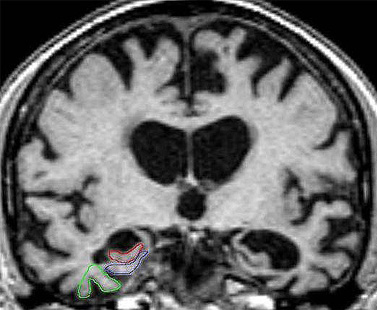Neurology Scans - a new Flesh & Stone feature
Introducing a recurring "Neurology Scan" feature highlighting news and tidbits you might have missed. This scan includes briefs on transcranial magnetic stimulation for depression, new developments in non-hormonal treatment for menopause, MRIs and Alzheimer's disease diagnosis, a new blog for diabetes patients, and circumcision as an HIV preventative.
The field of neurology intersects with so many aspects of research, culture, business and politics that it seems important to pass along some of the interesting finds that might not have received a lot of attention. Thus, I'm introducing a recurring "Neurology Scan" feature. Watch for it weekly. This scan includes briefs on transcranial magnetic stimulation for depression, new developments in non-hormonal treatment for menopause, MRIs and Alzheimer's disease diagnosis, a new blog for diabetes patients, and circumcision as an HIV preventative.
Magnetic Stimulation Device Okayed for Depression Treatment
At Dana.org, Aalok Mehta writes about the first transcranial magnetic stimulation (TMS) device to be cleared by the FDA for the treatment of depression.
“Neurostar, manufactured by Malvern, Pa.–based Neuronetics, involves rapidly sending magnetic pulses into the skull,” according to the article. “This triggers electrical activity in the prefrontal cortex, which is believed in turn to affect areas of the brain tied to mood.
Mehta notes that TMS is a non-invasive alternative to the controversial electroconvulsive therapy (ECT) and can be used to diagnose and other disorders such as stroke, multiple sclerosis and motor neuron diseases. -- Dana.org
Alternatives to hormonal therapy for menopause on the way
Market intelligence company Datamonitor predicts a growing market for non-hormonal treatment of menopausal symptoms.
While not as effective for managing hot flashes and night sweats as hormonal therapies, non-hormonal drugs may be an option for women who are turned off on HRT because of safety risks, and those with breast cancer and certain cardiovascular disorders would cannot take HRT.
Four drugs, including currently marketed antidepressants and an anticonvulsant, are being reformulated as non-hormonal treatments of menopausal symptoms, reports Datamonitor.
One of the new drugs, Pristiq, “could be the first non-hormonal treatment to enter the menopause market in early 2009,” according to the report which cites a 64 percent reduction in hot flashes with Pritiq, compared to Premarin, the leading HRT drug, which reduces the frequency of hot flashes by 94 percent.
The firm estimates a 115 million woman market for menopause symptom relief. -- Fierce Markets and Datamonitor
MRI brain scans accurate in early diagnosis of Alzheimer’s diseaseMRI scans that detect shrinkage in specific regions of the mid-brain attacked by Alzheimer’s disease accurately diagnose the neurodegenerative disease, even before symptoms interfere with daily function, according to a study by the Florida Alzheimer’s Disease Research Center (ADRC) in Miami and Tampa.

MRI scan shows severe atrophy indicative of Alzheimer's pathology in all areas, except the right peripheral cortex, which has moderate atrophy. Image: University of South Florida
The Florida researchers used a new visual rating system to evaluate the severity of shrinkage, or atrophy, in the brain’s medial temporal lobe. The study included 260 people, some with probable Alzheimer’s disease, some with varying degrees of cognitive impairment and some who had normal aging of the brain.
"We advocate, based on these findings, that the criteria for the diagnosis of Alzheimer’s disease should include MRI scans,” said the study’s lead author Ranjan Duara, MD, medical director of the Wien Center for Alzheimer’s Disease and Memory Disorders at Mount Sinai Medical Center.
The study was published in Neurology this month. -- University of South Florida
Mayo Clinic.com launches living with diabetes blog
About 23.6 million Americans have diabetes, according to the American Diabetes Association. Of those, one out of four is unaware that they have the disease. Two Mayo Clinic RNs, Nancy Klobassa and Peggy Moreland, have launched a blog to raise awareness about diabetes and help people manage the disease.
“Uncontrolled diabetes can lead to serious complications, such as blindness, kidney damage, heart disease, and lower-limb amputations,” according to Klobassa and Moreland. “Persons with diabetes can decrease their risk of complications by controlling their blood glucose, blood pressure, and cholesterol.” -- Mayoclinic.com
Circumcision Cuts HIV Infection in Heterosexual Men
The United Nations Joint Programme on HIV/AIDS (UNAIDS) has recommended that safe circumcision services be increased in countries with high HIV prevalence.
“Trials in Kenya, Uganda and South Africa have now demonstrated that male circumcision can reduce the rate of HIV infection in men in heterosexual relationships by 50 - 60 percent,” wrote Wynfred Russell in Mshale, a newspaper for African immigrants in the Americas.
The NIH study found that circumcision reduced a heterosexual man’s risk of acquiring HIV infection by 64 percent. The study enrolled 2,784 Kenyan men for up to three and a half years. -- Mshale



 del.icio.us
del.icio.us Digg
Digg












Post your comment